Marketing Strategies for Boost Juice in the International Market
VerifiedAdded on 2023/06/03
|7
|2250
|292
Report
AI Summary
This report analyzes the international marketing strategies of Boost Juice, a brand specializing in juices, smoothies, and juice bars. The report examines various marketing techniques employed by Boost, including low pricing strategies, product customization based on customer preferences, and the use of above-the-line and below-the-line marketing. It explores the company's approach to franchising and its adaptation to cultural differences, specifically comparing the Australian and American markets. The analysis includes market segmentation, the application of the marketing mix (4Ps), and the use of Hofstede's cultural dimensions to understand intercultural communication. The report concludes with an assessment of Boost Juice's potential for expansion into the American market, considering the country's economic conditions, consumer preferences, and regulatory environment, along with recommendations for promotional strategies and market segmentation within the US.
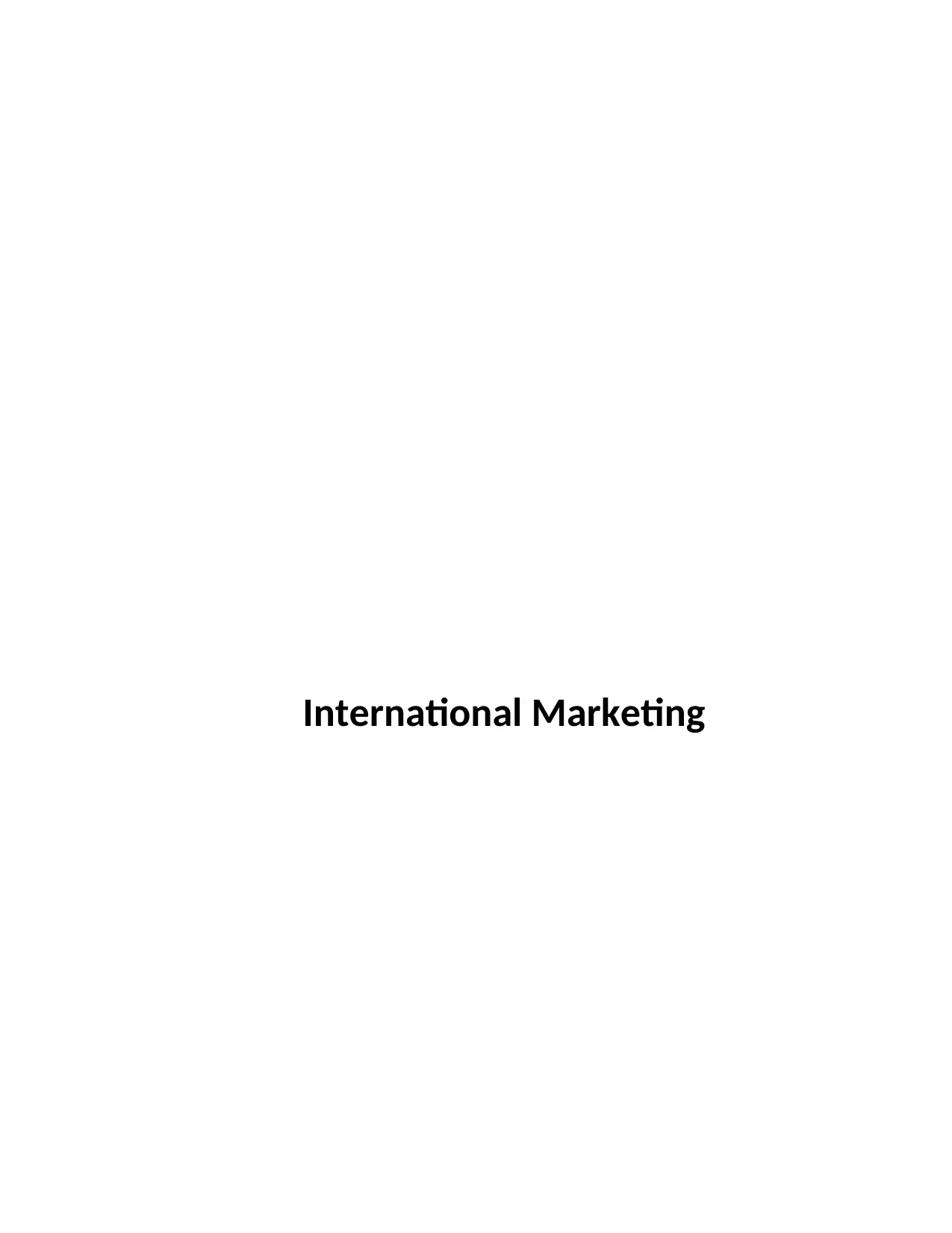
International Marketing
Paraphrase This Document
Need a fresh take? Get an instant paraphrase of this document with our AI Paraphraser
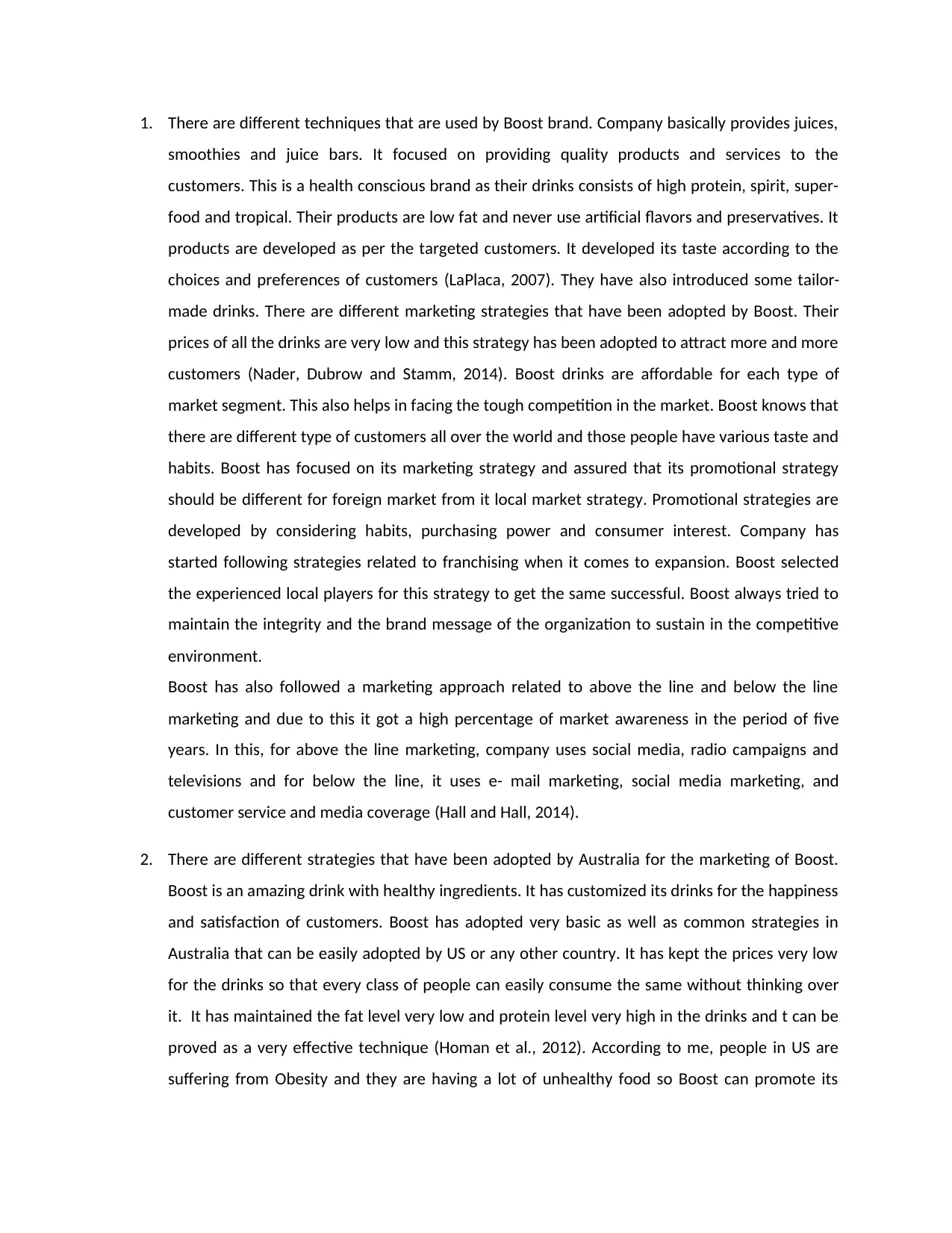
1. There are different techniques that are used by Boost brand. Company basically provides juices,
smoothies and juice bars. It focused on providing quality products and services to the
customers. This is a health conscious brand as their drinks consists of high protein, spirit, super-
food and tropical. Their products are low fat and never use artificial flavors and preservatives. It
products are developed as per the targeted customers. It developed its taste according to the
choices and preferences of customers (LaPlaca, 2007). They have also introduced some tailor-
made drinks. There are different marketing strategies that have been adopted by Boost. Their
prices of all the drinks are very low and this strategy has been adopted to attract more and more
customers (Nader, Dubrow and Stamm, 2014). Boost drinks are affordable for each type of
market segment. This also helps in facing the tough competition in the market. Boost knows that
there are different type of customers all over the world and those people have various taste and
habits. Boost has focused on its marketing strategy and assured that its promotional strategy
should be different for foreign market from it local market strategy. Promotional strategies are
developed by considering habits, purchasing power and consumer interest. Company has
started following strategies related to franchising when it comes to expansion. Boost selected
the experienced local players for this strategy to get the same successful. Boost always tried to
maintain the integrity and the brand message of the organization to sustain in the competitive
environment.
Boost has also followed a marketing approach related to above the line and below the line
marketing and due to this it got a high percentage of market awareness in the period of five
years. In this, for above the line marketing, company uses social media, radio campaigns and
televisions and for below the line, it uses e- mail marketing, social media marketing, and
customer service and media coverage (Hall and Hall, 2014).
2. There are different strategies that have been adopted by Australia for the marketing of Boost.
Boost is an amazing drink with healthy ingredients. It has customized its drinks for the happiness
and satisfaction of customers. Boost has adopted very basic as well as common strategies in
Australia that can be easily adopted by US or any other country. It has kept the prices very low
for the drinks so that every class of people can easily consume the same without thinking over
it. It has maintained the fat level very low and protein level very high in the drinks and t can be
proved as a very effective technique (Homan et al., 2012). According to me, people in US are
suffering from Obesity and they are having a lot of unhealthy food so Boost can promote its
smoothies and juice bars. It focused on providing quality products and services to the
customers. This is a health conscious brand as their drinks consists of high protein, spirit, super-
food and tropical. Their products are low fat and never use artificial flavors and preservatives. It
products are developed as per the targeted customers. It developed its taste according to the
choices and preferences of customers (LaPlaca, 2007). They have also introduced some tailor-
made drinks. There are different marketing strategies that have been adopted by Boost. Their
prices of all the drinks are very low and this strategy has been adopted to attract more and more
customers (Nader, Dubrow and Stamm, 2014). Boost drinks are affordable for each type of
market segment. This also helps in facing the tough competition in the market. Boost knows that
there are different type of customers all over the world and those people have various taste and
habits. Boost has focused on its marketing strategy and assured that its promotional strategy
should be different for foreign market from it local market strategy. Promotional strategies are
developed by considering habits, purchasing power and consumer interest. Company has
started following strategies related to franchising when it comes to expansion. Boost selected
the experienced local players for this strategy to get the same successful. Boost always tried to
maintain the integrity and the brand message of the organization to sustain in the competitive
environment.
Boost has also followed a marketing approach related to above the line and below the line
marketing and due to this it got a high percentage of market awareness in the period of five
years. In this, for above the line marketing, company uses social media, radio campaigns and
televisions and for below the line, it uses e- mail marketing, social media marketing, and
customer service and media coverage (Hall and Hall, 2014).
2. There are different strategies that have been adopted by Australia for the marketing of Boost.
Boost is an amazing drink with healthy ingredients. It has customized its drinks for the happiness
and satisfaction of customers. Boost has adopted very basic as well as common strategies in
Australia that can be easily adopted by US or any other country. It has kept the prices very low
for the drinks so that every class of people can easily consume the same without thinking over
it. It has maintained the fat level very low and protein level very high in the drinks and t can be
proved as a very effective technique (Homan et al., 2012). According to me, people in US are
suffering from Obesity and they are having a lot of unhealthy food so Boost can promote its
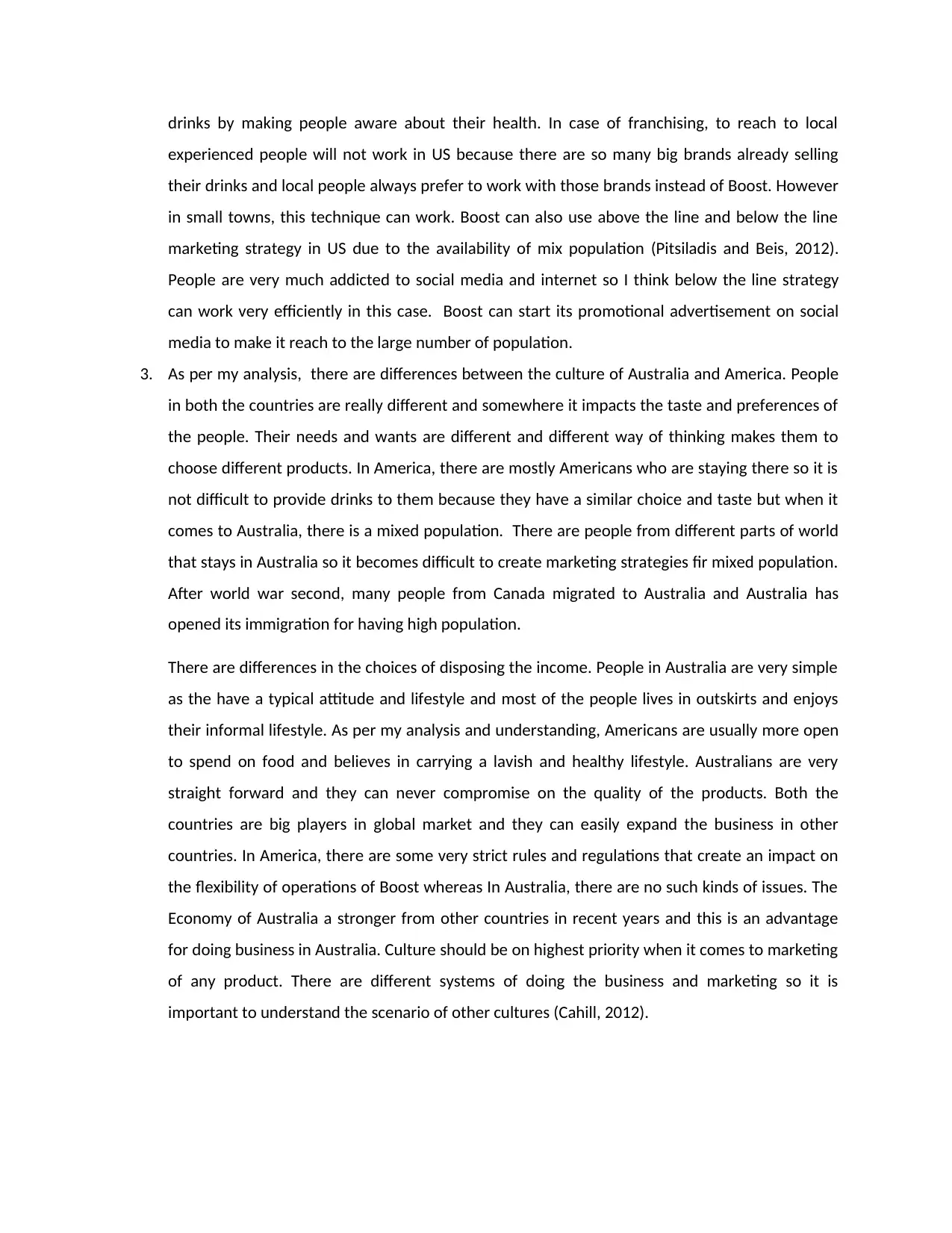
drinks by making people aware about their health. In case of franchising, to reach to local
experienced people will not work in US because there are so many big brands already selling
their drinks and local people always prefer to work with those brands instead of Boost. However
in small towns, this technique can work. Boost can also use above the line and below the line
marketing strategy in US due to the availability of mix population (Pitsiladis and Beis, 2012).
People are very much addicted to social media and internet so I think below the line strategy
can work very efficiently in this case. Boost can start its promotional advertisement on social
media to make it reach to the large number of population.
3. As per my analysis, there are differences between the culture of Australia and America. People
in both the countries are really different and somewhere it impacts the taste and preferences of
the people. Their needs and wants are different and different way of thinking makes them to
choose different products. In America, there are mostly Americans who are staying there so it is
not difficult to provide drinks to them because they have a similar choice and taste but when it
comes to Australia, there is a mixed population. There are people from different parts of world
that stays in Australia so it becomes difficult to create marketing strategies fir mixed population.
After world war second, many people from Canada migrated to Australia and Australia has
opened its immigration for having high population.
There are differences in the choices of disposing the income. People in Australia are very simple
as the have a typical attitude and lifestyle and most of the people lives in outskirts and enjoys
their informal lifestyle. As per my analysis and understanding, Americans are usually more open
to spend on food and believes in carrying a lavish and healthy lifestyle. Australians are very
straight forward and they can never compromise on the quality of the products. Both the
countries are big players in global market and they can easily expand the business in other
countries. In America, there are some very strict rules and regulations that create an impact on
the flexibility of operations of Boost whereas In Australia, there are no such kinds of issues. The
Economy of Australia a stronger from other countries in recent years and this is an advantage
for doing business in Australia. Culture should be on highest priority when it comes to marketing
of any product. There are different systems of doing the business and marketing so it is
important to understand the scenario of other cultures (Cahill, 2012).
experienced people will not work in US because there are so many big brands already selling
their drinks and local people always prefer to work with those brands instead of Boost. However
in small towns, this technique can work. Boost can also use above the line and below the line
marketing strategy in US due to the availability of mix population (Pitsiladis and Beis, 2012).
People are very much addicted to social media and internet so I think below the line strategy
can work very efficiently in this case. Boost can start its promotional advertisement on social
media to make it reach to the large number of population.
3. As per my analysis, there are differences between the culture of Australia and America. People
in both the countries are really different and somewhere it impacts the taste and preferences of
the people. Their needs and wants are different and different way of thinking makes them to
choose different products. In America, there are mostly Americans who are staying there so it is
not difficult to provide drinks to them because they have a similar choice and taste but when it
comes to Australia, there is a mixed population. There are people from different parts of world
that stays in Australia so it becomes difficult to create marketing strategies fir mixed population.
After world war second, many people from Canada migrated to Australia and Australia has
opened its immigration for having high population.
There are differences in the choices of disposing the income. People in Australia are very simple
as the have a typical attitude and lifestyle and most of the people lives in outskirts and enjoys
their informal lifestyle. As per my analysis and understanding, Americans are usually more open
to spend on food and believes in carrying a lavish and healthy lifestyle. Australians are very
straight forward and they can never compromise on the quality of the products. Both the
countries are big players in global market and they can easily expand the business in other
countries. In America, there are some very strict rules and regulations that create an impact on
the flexibility of operations of Boost whereas In Australia, there are no such kinds of issues. The
Economy of Australia a stronger from other countries in recent years and this is an advantage
for doing business in Australia. Culture should be on highest priority when it comes to marketing
of any product. There are different systems of doing the business and marketing so it is
important to understand the scenario of other cultures (Cahill, 2012).
⊘ This is a preview!⊘
Do you want full access?
Subscribe today to unlock all pages.

Trusted by 1+ million students worldwide
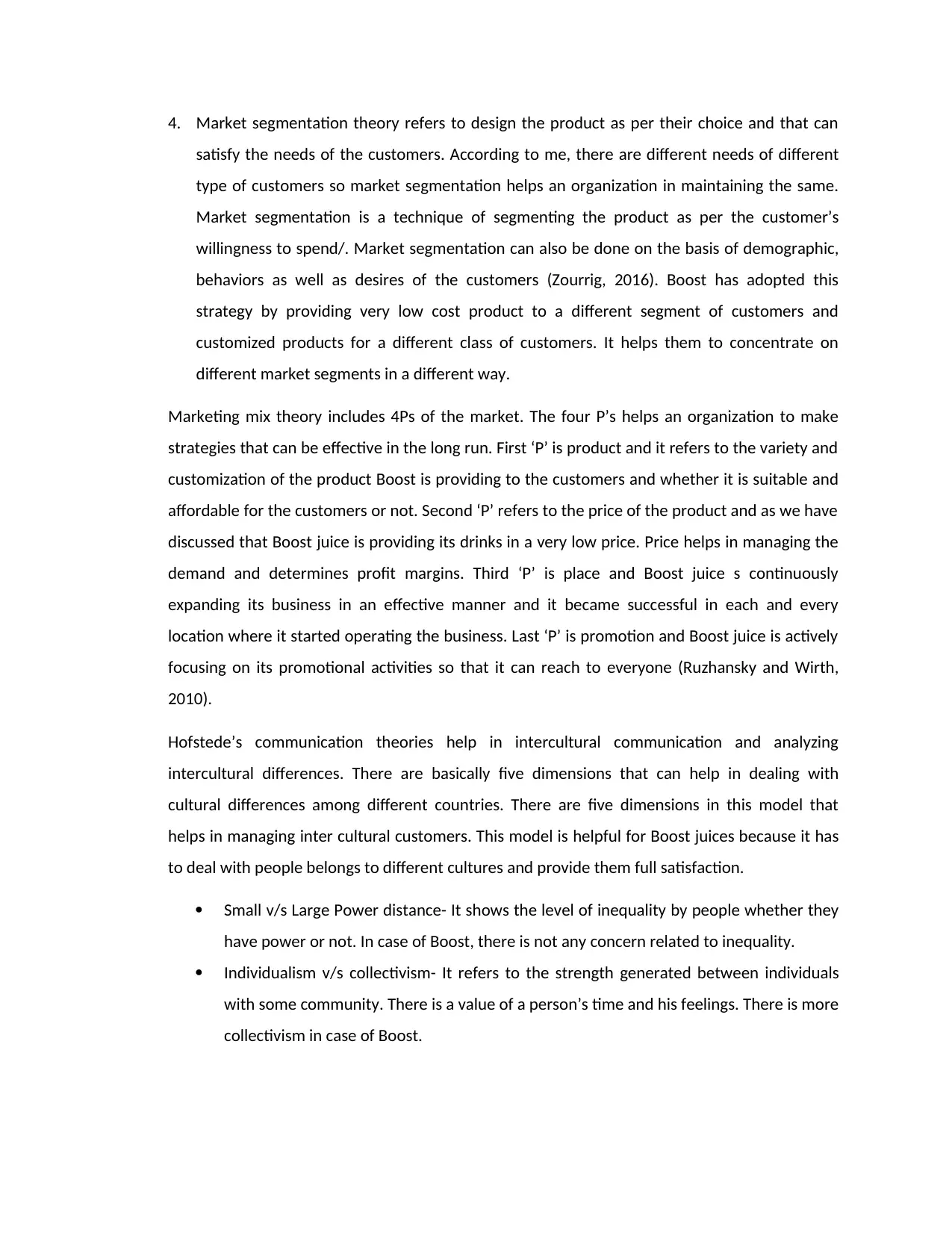
4. Market segmentation theory refers to design the product as per their choice and that can
satisfy the needs of the customers. According to me, there are different needs of different
type of customers so market segmentation helps an organization in maintaining the same.
Market segmentation is a technique of segmenting the product as per the customer’s
willingness to spend/. Market segmentation can also be done on the basis of demographic,
behaviors as well as desires of the customers (Zourrig, 2016). Boost has adopted this
strategy by providing very low cost product to a different segment of customers and
customized products for a different class of customers. It helps them to concentrate on
different market segments in a different way.
Marketing mix theory includes 4Ps of the market. The four P’s helps an organization to make
strategies that can be effective in the long run. First ‘P’ is product and it refers to the variety and
customization of the product Boost is providing to the customers and whether it is suitable and
affordable for the customers or not. Second ‘P’ refers to the price of the product and as we have
discussed that Boost juice is providing its drinks in a very low price. Price helps in managing the
demand and determines profit margins. Third ‘P’ is place and Boost juice s continuously
expanding its business in an effective manner and it became successful in each and every
location where it started operating the business. Last ‘P’ is promotion and Boost juice is actively
focusing on its promotional activities so that it can reach to everyone (Ruzhansky and Wirth,
2010).
Hofstede’s communication theories help in intercultural communication and analyzing
intercultural differences. There are basically five dimensions that can help in dealing with
cultural differences among different countries. There are five dimensions in this model that
helps in managing inter cultural customers. This model is helpful for Boost juices because it has
to deal with people belongs to different cultures and provide them full satisfaction.
Small v/s Large Power distance- It shows the level of inequality by people whether they
have power or not. In case of Boost, there is not any concern related to inequality.
Individualism v/s collectivism- It refers to the strength generated between individuals
with some community. There is a value of a person’s time and his feelings. There is more
collectivism in case of Boost.
satisfy the needs of the customers. According to me, there are different needs of different
type of customers so market segmentation helps an organization in maintaining the same.
Market segmentation is a technique of segmenting the product as per the customer’s
willingness to spend/. Market segmentation can also be done on the basis of demographic,
behaviors as well as desires of the customers (Zourrig, 2016). Boost has adopted this
strategy by providing very low cost product to a different segment of customers and
customized products for a different class of customers. It helps them to concentrate on
different market segments in a different way.
Marketing mix theory includes 4Ps of the market. The four P’s helps an organization to make
strategies that can be effective in the long run. First ‘P’ is product and it refers to the variety and
customization of the product Boost is providing to the customers and whether it is suitable and
affordable for the customers or not. Second ‘P’ refers to the price of the product and as we have
discussed that Boost juice is providing its drinks in a very low price. Price helps in managing the
demand and determines profit margins. Third ‘P’ is place and Boost juice s continuously
expanding its business in an effective manner and it became successful in each and every
location where it started operating the business. Last ‘P’ is promotion and Boost juice is actively
focusing on its promotional activities so that it can reach to everyone (Ruzhansky and Wirth,
2010).
Hofstede’s communication theories help in intercultural communication and analyzing
intercultural differences. There are basically five dimensions that can help in dealing with
cultural differences among different countries. There are five dimensions in this model that
helps in managing inter cultural customers. This model is helpful for Boost juices because it has
to deal with people belongs to different cultures and provide them full satisfaction.
Small v/s Large Power distance- It shows the level of inequality by people whether they
have power or not. In case of Boost, there is not any concern related to inequality.
Individualism v/s collectivism- It refers to the strength generated between individuals
with some community. There is a value of a person’s time and his feelings. There is more
collectivism in case of Boost.
Paraphrase This Document
Need a fresh take? Get an instant paraphrase of this document with our AI Paraphraser
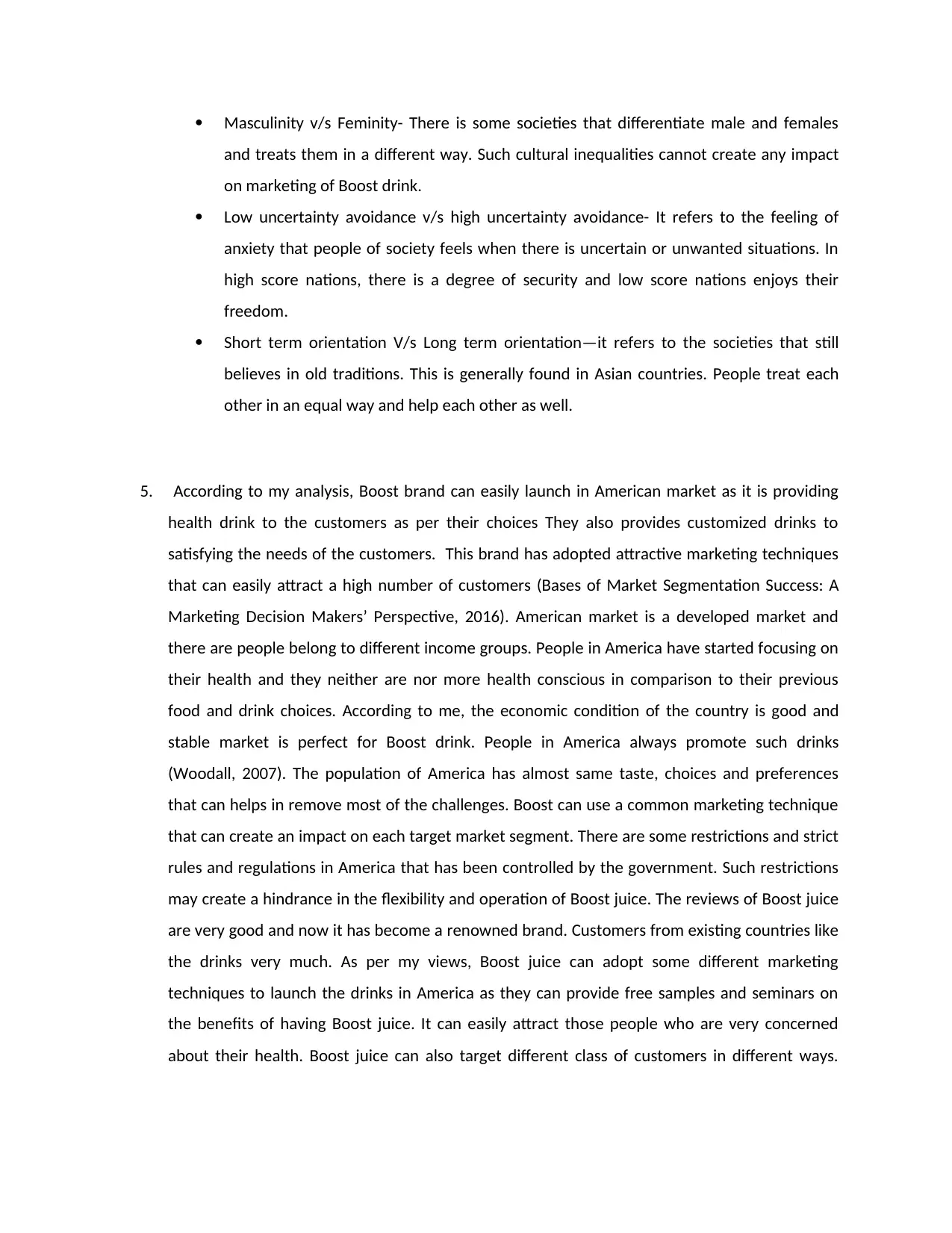
Masculinity v/s Feminity- There is some societies that differentiate male and females
and treats them in a different way. Such cultural inequalities cannot create any impact
on marketing of Boost drink.
Low uncertainty avoidance v/s high uncertainty avoidance- It refers to the feeling of
anxiety that people of society feels when there is uncertain or unwanted situations. In
high score nations, there is a degree of security and low score nations enjoys their
freedom.
Short term orientation V/s Long term orientation—it refers to the societies that still
believes in old traditions. This is generally found in Asian countries. People treat each
other in an equal way and help each other as well.
5. According to my analysis, Boost brand can easily launch in American market as it is providing
health drink to the customers as per their choices They also provides customized drinks to
satisfying the needs of the customers. This brand has adopted attractive marketing techniques
that can easily attract a high number of customers (Bases of Market Segmentation Success: A
Marketing Decision Makers’ Perspective, 2016). American market is a developed market and
there are people belong to different income groups. People in America have started focusing on
their health and they neither are nor more health conscious in comparison to their previous
food and drink choices. According to me, the economic condition of the country is good and
stable market is perfect for Boost drink. People in America always promote such drinks
(Woodall, 2007). The population of America has almost same taste, choices and preferences
that can helps in remove most of the challenges. Boost can use a common marketing technique
that can create an impact on each target market segment. There are some restrictions and strict
rules and regulations in America that has been controlled by the government. Such restrictions
may create a hindrance in the flexibility and operation of Boost juice. The reviews of Boost juice
are very good and now it has become a renowned brand. Customers from existing countries like
the drinks very much. As per my views, Boost juice can adopt some different marketing
techniques to launch the drinks in America as they can provide free samples and seminars on
the benefits of having Boost juice. It can easily attract those people who are very concerned
about their health. Boost juice can also target different class of customers in different ways.
and treats them in a different way. Such cultural inequalities cannot create any impact
on marketing of Boost drink.
Low uncertainty avoidance v/s high uncertainty avoidance- It refers to the feeling of
anxiety that people of society feels when there is uncertain or unwanted situations. In
high score nations, there is a degree of security and low score nations enjoys their
freedom.
Short term orientation V/s Long term orientation—it refers to the societies that still
believes in old traditions. This is generally found in Asian countries. People treat each
other in an equal way and help each other as well.
5. According to my analysis, Boost brand can easily launch in American market as it is providing
health drink to the customers as per their choices They also provides customized drinks to
satisfying the needs of the customers. This brand has adopted attractive marketing techniques
that can easily attract a high number of customers (Bases of Market Segmentation Success: A
Marketing Decision Makers’ Perspective, 2016). American market is a developed market and
there are people belong to different income groups. People in America have started focusing on
their health and they neither are nor more health conscious in comparison to their previous
food and drink choices. According to me, the economic condition of the country is good and
stable market is perfect for Boost drink. People in America always promote such drinks
(Woodall, 2007). The population of America has almost same taste, choices and preferences
that can helps in remove most of the challenges. Boost can use a common marketing technique
that can create an impact on each target market segment. There are some restrictions and strict
rules and regulations in America that has been controlled by the government. Such restrictions
may create a hindrance in the flexibility and operation of Boost juice. The reviews of Boost juice
are very good and now it has become a renowned brand. Customers from existing countries like
the drinks very much. As per my views, Boost juice can adopt some different marketing
techniques to launch the drinks in America as they can provide free samples and seminars on
the benefits of having Boost juice. It can easily attract those people who are very concerned
about their health. Boost juice can also target different class of customers in different ways.
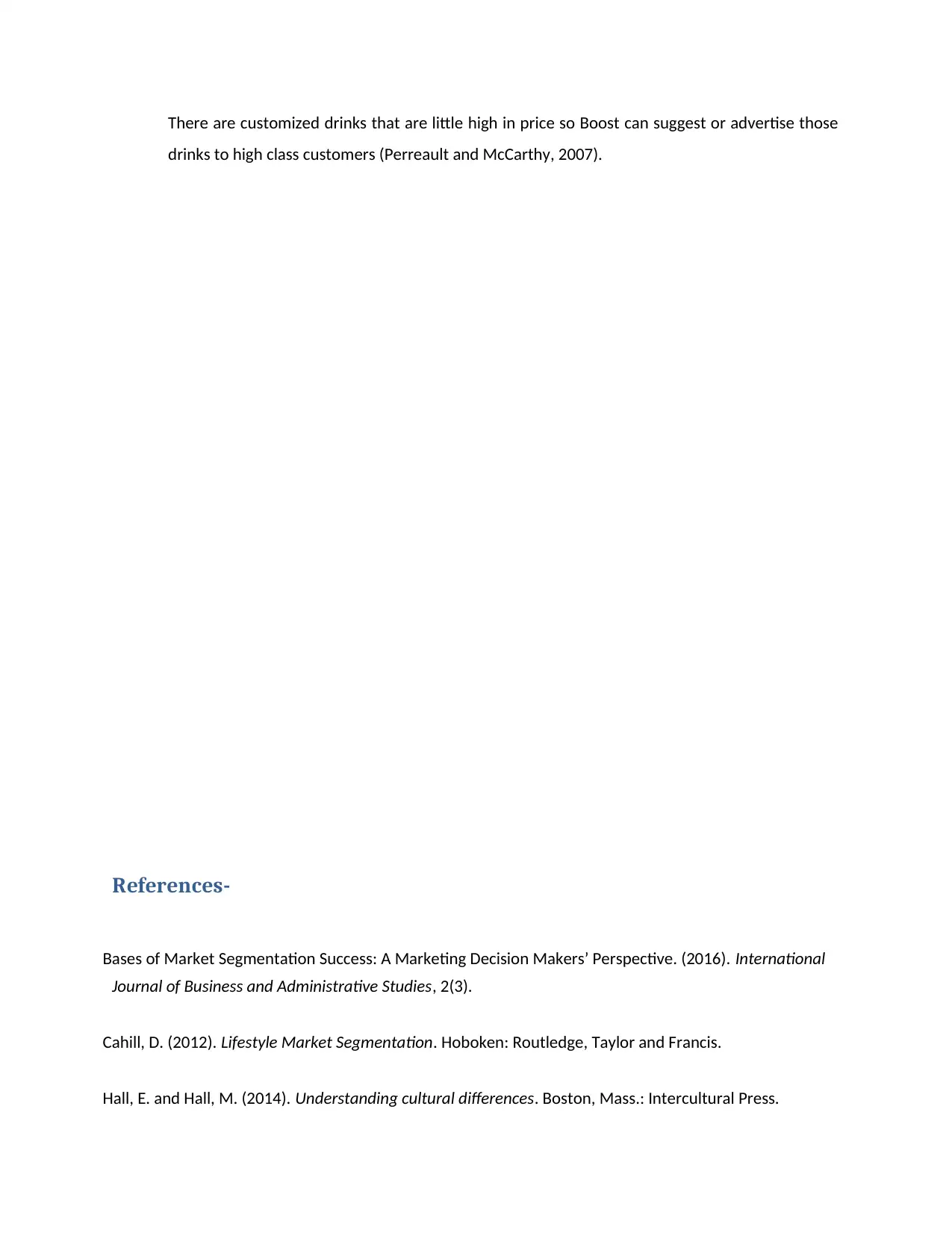
There are customized drinks that are little high in price so Boost can suggest or advertise those
drinks to high class customers (Perreault and McCarthy, 2007).
References-
Bases of Market Segmentation Success: A Marketing Decision Makers’ Perspective. (2016). International
Journal of Business and Administrative Studies, 2(3).
Cahill, D. (2012). Lifestyle Market Segmentation. Hoboken: Routledge, Taylor and Francis.
Hall, E. and Hall, M. (2014). Understanding cultural differences. Boston, Mass.: Intercultural Press.
drinks to high class customers (Perreault and McCarthy, 2007).
References-
Bases of Market Segmentation Success: A Marketing Decision Makers’ Perspective. (2016). International
Journal of Business and Administrative Studies, 2(3).
Cahill, D. (2012). Lifestyle Market Segmentation. Hoboken: Routledge, Taylor and Francis.
Hall, E. and Hall, M. (2014). Understanding cultural differences. Boston, Mass.: Intercultural Press.
⊘ This is a preview!⊘
Do you want full access?
Subscribe today to unlock all pages.

Trusted by 1+ million students worldwide
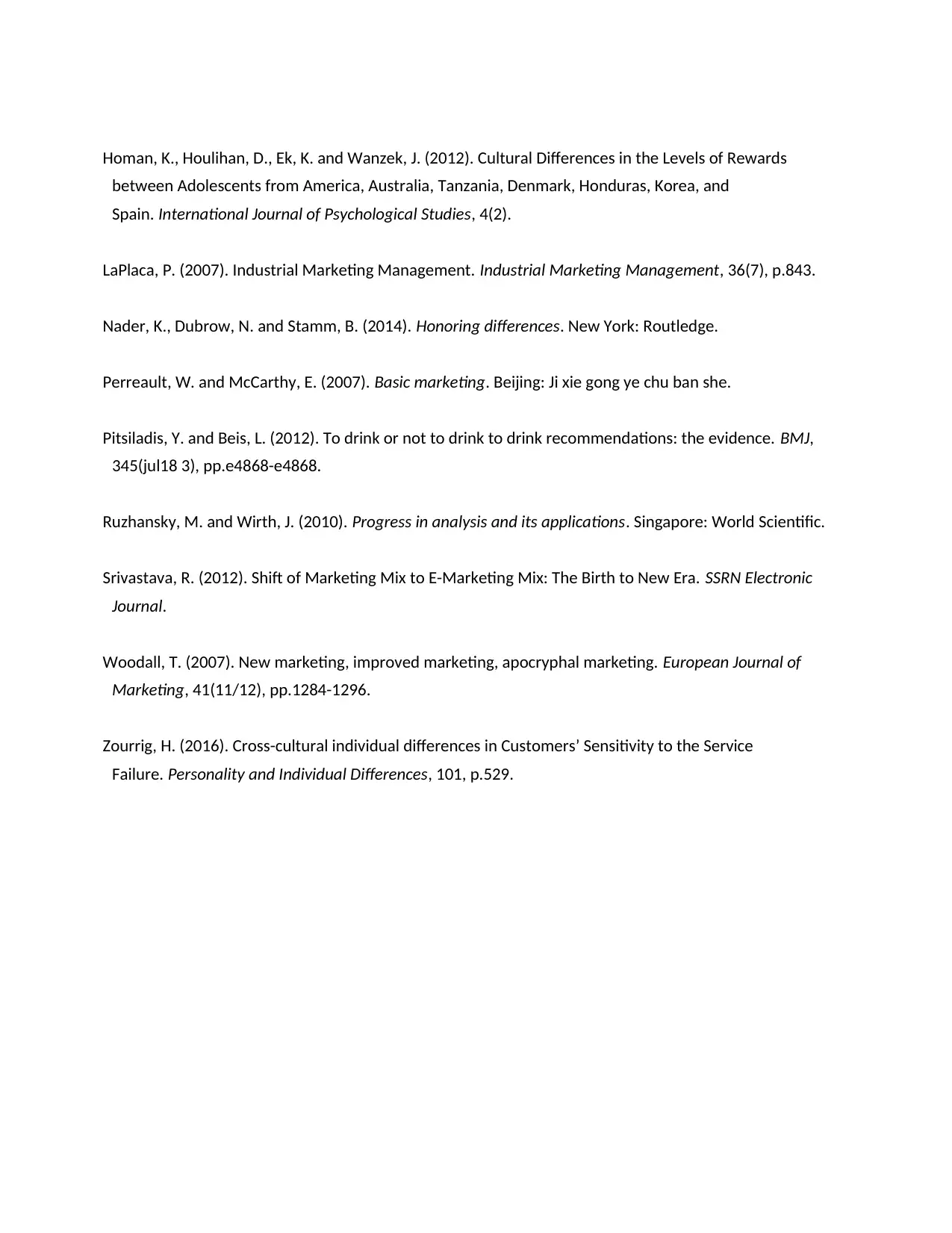
Homan, K., Houlihan, D., Ek, K. and Wanzek, J. (2012). Cultural Differences in the Levels of Rewards
between Adolescents from America, Australia, Tanzania, Denmark, Honduras, Korea, and
Spain. International Journal of Psychological Studies, 4(2).
LaPlaca, P. (2007). Industrial Marketing Management. Industrial Marketing Management, 36(7), p.843.
Nader, K., Dubrow, N. and Stamm, B. (2014). Honoring differences. New York: Routledge.
Perreault, W. and McCarthy, E. (2007). Basic marketing. Beijing: Ji xie gong ye chu ban she.
Pitsiladis, Y. and Beis, L. (2012). To drink or not to drink to drink recommendations: the evidence. BMJ,
345(jul18 3), pp.e4868-e4868.
Ruzhansky, M. and Wirth, J. (2010). Progress in analysis and its applications. Singapore: World Scientific.
Srivastava, R. (2012). Shift of Marketing Mix to E-Marketing Mix: The Birth to New Era. SSRN Electronic
Journal.
Woodall, T. (2007). New marketing, improved marketing, apocryphal marketing. European Journal of
Marketing, 41(11/12), pp.1284-1296.
Zourrig, H. (2016). Cross-cultural individual differences in Customers’ Sensitivity to the Service
Failure. Personality and Individual Differences, 101, p.529.
between Adolescents from America, Australia, Tanzania, Denmark, Honduras, Korea, and
Spain. International Journal of Psychological Studies, 4(2).
LaPlaca, P. (2007). Industrial Marketing Management. Industrial Marketing Management, 36(7), p.843.
Nader, K., Dubrow, N. and Stamm, B. (2014). Honoring differences. New York: Routledge.
Perreault, W. and McCarthy, E. (2007). Basic marketing. Beijing: Ji xie gong ye chu ban she.
Pitsiladis, Y. and Beis, L. (2012). To drink or not to drink to drink recommendations: the evidence. BMJ,
345(jul18 3), pp.e4868-e4868.
Ruzhansky, M. and Wirth, J. (2010). Progress in analysis and its applications. Singapore: World Scientific.
Srivastava, R. (2012). Shift of Marketing Mix to E-Marketing Mix: The Birth to New Era. SSRN Electronic
Journal.
Woodall, T. (2007). New marketing, improved marketing, apocryphal marketing. European Journal of
Marketing, 41(11/12), pp.1284-1296.
Zourrig, H. (2016). Cross-cultural individual differences in Customers’ Sensitivity to the Service
Failure. Personality and Individual Differences, 101, p.529.
1 out of 7
Related Documents
Your All-in-One AI-Powered Toolkit for Academic Success.
+13062052269
info@desklib.com
Available 24*7 on WhatsApp / Email
![[object Object]](/_next/static/media/star-bottom.7253800d.svg)
Unlock your academic potential
Copyright © 2020–2025 A2Z Services. All Rights Reserved. Developed and managed by ZUCOL.




